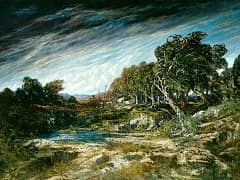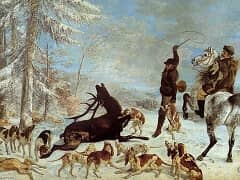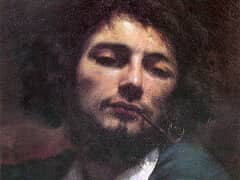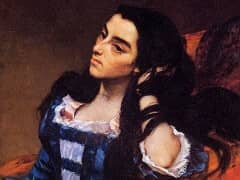Self Portrait with a Black Dog, 1844

The young Courbet presents himself here in one of the several different personae by means of which he explored both his own self-image and the pictorial and cultural traditions that were available to him during the early 1840s. Here the figure of the young man is the picture of poised self-containment. His elegant clothes (the coat carefully turned back to reveal the dashing yellow lining), his fashionable English spaniel, and the lofty perch from which he can cast a rather superior gaze down upon the world beneath him identify him quite clearly as a dandy. Originating in the style and manners of Regency England, the image of the dandy in France became not only a model of superior fashion but a concept rich in implication for everything from social posture (Stendhal) to poetry (Baudelaire).
For the young man from the rustic country of the Doubs, new to Paris, it would have been a new and very sophisticated notion, and a fascinating one to explore in relation to his own selfhood. Here Courbet places the figure of a debonair young man in a landscape of his native countryside, seated against an outcropping of its familiar steep, chalky rock. The image of the dandy is fused with that of the country boy that Courbet in fact was, the fellow who goes on long tramps in the woods and fields with his faithful dog and his briar stick, taking a rest now and then to enjoy his pipe. But this fellow is also yet another character, for he has long, flowing hair, protected by a wide broad-brimmed hat, and he takes his walk with a book. Knowing that the subject is a painter, we might assume this to be a sketchbook; but there is nothing to tell us so, and it could as easily be a volume of poetry. In either guise he plays his role as the image of the young Romantic, poet or painter or painter-poet, centrally situated in the midst of what Romantic culture was making into a fundamental theme of art - the landscape. Perhaps because of its qualities of stylishness (though one can never really second-guess a Salon jury), this self-portrait was accepted to be shown in the Salon of 1844 - one of three paintings accepted out of the twenty-four submitted by Courbet between 1841 and 1847. The date of 1842 on the painting is considered questionable, as are many of the dates on the paintings of an artist who often signed and dated his works when they were going to be sold or exhibited. In this case, a small portrait with the same black spaniel, dated 1842 and now in the Town Hall of Pontarlier, provides a point of comparison.















